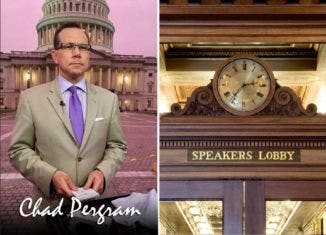Symbology
The Speaker’s Lobby: Symbology
By: Chad Pergram, FOX News
28 May 2009
Symbologist Robert Langdon hit the silver screen again recently.
Tom Hanks first portrayed Langdon a few years ago in “The Da Vinci Code.” He reprised the role of the fictional Harvard professor in the recently released “Angels and Demons.”
In the movie, Langdon’s academic study of symbols, history, religion and art help him uncover a plot by The Illuminati to paralyze the Catholic Church. Langdon traces the path of the Illuminati through the cathedrals and sculptures of Rome. He finally discovers that the Illuminati have infiltrated the Holy See.
Unlike Langdon, I don’t know much about religious icons, Vatican lore and the geography of Rome. But as I watched “Angels and Demons,” I realized there was a version of Congressional symbology, too. And to the uninitiated, decoding Congressional symbols and icons can reveal volumes about the daily work that takes places here on Capitol Hill. The trick is knowing what to look for. And then properly interpreting these tokens to decipher the work of Congress.
Here’s a list of some of the symbols I interpret daily at the Capitol.
Speaker’s Feng Shui
In Feng Shui, the Chinese have long advocated for the appropriate positioning of furniture so as not to block the flow of Chi or energy. Feng Shui experts will often rearrange an entire room to better control the energy. House Speaker Nancy Pelosi (D-CA) is visiting China this week. But her staff has practiced Feng Shui for years. Pelosi’s Feng Shui is most obvious when you can spot a couch resting out in a hallway near the Speaker’s ceremonial office. To the naked eye a sofa seems innocuous. Like someone is just moving furniture. But seeing a certain couch in a certain hallway at a certain time of the week often means a high-profile TV correspondent is interviewing Pelosi for one of the Sunday talk shows. That’s because TV crews inside the office deported the couch to the corridor to make room for their lights and gear. A couch in the hall tells me I should watch for the Speaker to show up on one of FOX’s competitors Sunday morning.
Appropriations DEFCON
The military has a series of defense readiness conditions, better known as DEFCONs. They’re arranged progressively, contingent on the severity of the crisis.
House Appropriations Committee Chairman Dave Obey (D-WI) seems to have a DEFCON system of his own. Heading the appropriations panel is one of the most thankless jobs at the Capitol, piloting through the House the 12 spending bills that run the federal government. And you can tell when Obey’s really in the thick of crunching the numbers. Just look to see how many pencils the Wisconsin Democrat sports in the breast pocket of his suit jacket.
In other words, if Obey has no pencils in his pocket, then he’s probably not appropriations matters that day. But if you spy one pencil, Obey’s progressed to Appropriations DEFCON4. That’s just one step up from condition normal, but a good sign that Obey’s really hitting it hard. During the most strenuous days of the appropriations season, look for Obey to carry as many as three or four pencils in his pocket. But never five. Five pencils in Obey’s pocket would be the appropriations equivalent of DEFCON1. And much like the U.S. military, Obey has never gone to the most grave, defensive posture.
Roaming Calls
As elections creep closer, most Capitol Hill observers turn to campaign experts like the University of Virginia’s Larry Sabato or Charlie Cook of the Cook Political Report to see which lawmakers face the toughest re-election fights.
Still there are always a few races that catch even the best Congressional watchers off guard.
But if you troll the perimeter of the House chamber during votes, you can always uncover on a handful of other Members of Congress, unexpectedly dogpaddling for their seats. They’ll be the ones, roaming the hallway, a cell phone affixed to their ear. They’re dialing for dollars with voters back home. Last year, I knew that Reps. John Shadegg (R-AZ), Virgil Goode (R-VA) and Mark Souder (R-IN) were facing challenging races long before anyone had that trio on their radar screens. That’s because I’d always see those three walking the hall, working the phone during votes. And if someone starts popping up in the hall this time of year, you can bet they’re either anticipating a tough primary or contemplating a run for higher office.
Ten-One-Hundred
I worked in local TV and radio news in Cincinnati when I was in high school and college. That’s where I discovered the art of listening to a police scanner. At one station we’d have six or seven scanner racing continuously through the frequencies, each one crackling with dispatchers hailing ambulances, police officers running license tags and calls for pumper trucks.
The trick was figuring out how to sift through all of the static and isolate a radio transmission that is really newsworthy. Like an out-of-breath officer chasing after someone who just knocked off a liquor store or a chemical plant explosion.
When Congressional hallways bustle with lobbyists, aides and lawmakers, its hard to hear over the din echoing off the marble floors. But I’ve trained my ears to perk up if I detect certain things on the radios carried by Capitol Hill Police officers. First I listen for a series of staccato tones. That usually means something important is happening. The tones are used to capture the attention of the police officers. And in this case, well-trained reporters. Secondly, I listen for the code “ten-one-hundred.” In Capitol police parlance, a “ten-one-hundred” usually means someone’s found an unattended briefcase or package. The police usually cordon off the corridor and sometimes even bring in dogs to sniff. The episodes usually turn out to be nothing. But “ten-one-hundreds” could trigger an evacuation of the Capitol.
Congressional Sonar
It’s critical to know the names and faces of Congressional aides and lobbyists. If you know what certain lobbyists look like, you can pick them out of a crowd when they journey to Capitol Hill to talk with lawmakers. And if you know who they are and what issues the lobbyists represent, you might be able to piece together a picture of what legislation is on a glide path to the House or Senate floors.
It’s helpful not to forget retired lawmakers. Former Members of Congress get lifetime access to the House and Senate. And if you remember what they look like, you’ll see them around all the time. Former Rep. Nancy Johnson (R-CT) at the Capitol discussing health care or former Sen. Ben Nighthorse Campbell (R-CO) chatting up former colleagues about Native American issues.
A variation of this is with aides. A smart reporter gets to know Congressional staff. Certainly staff can be helpful to a reporter. But more importantly, the presence of an aide near the House floor or lingering near a Senate hideaway office might indicate that the lawmaker is nearby. Years ago, I always spotted a man named David Smith hanging around the Senate Radio-TV Gallery. It didn’t take me long to learn that he handled press for Sen. Ted Kennedy (D-MA). And then I realized that Smith always walked by the Senate Radio-TV Gallery because he was shuttling between the Senate floor and Kennedy’s hideaway office (special, ornate, but out-of-the-way rooms reserved for senior senators). Smith’s presence was like beacon flashing that Kennedy was close.
Years later, I employ a type of Congressional sonar to trace the movements of aides and lobbyists inside the Capitol. And that helps me uncover the locations of elusive lawmakers.
When Cat crosses your path…
Most votes in the House are fairly routine. But there’s always a chance something can weird can happen.
A simple, procedural vote might suddenly become a nail biter.. The electronic voting system in the House chamber might fail. A lawmaker’s voting card might get stuck in a crack in the dais. The House might have to suspend a vote because an elevator hauling lawmakers up to the floor locks up and its going to take a half hour to get them out. Republicans decide to make Democrats wrestle with a resolution by Rep. Dennis Kucinich (D-OH) to impeach former Vice President Dick Cheney.
All are true, bizarre events that have unfolded during innocuous House votes.
With so much activity swirling around Capitol Hill each day, it’s impossible for me to monitor every vote for some strange episode. So during votes, I keep an eye out for a particular leadership staffer. Kind of like having a canary in the coal mine. Or in this case, a Cat in the House chamber. Specifically Cat O’Neill, deputy director of floor operations for House Speaker Nancy Pelosi (D-CA) and granddaughter to late House Speaker Tip O’Neill (D-MA).
Bottom line: if I see O’Neill run out of the chamber to her office across the hall, I know there’s a problem on the floor.
The most recent episode came two weeks ago as the House debated an anti-fraud bill. House Democrats skipped to a vote too quickly without slicing through the perfunctory but required “where as’s” and “to wit’s.” More than 100 lawmakers had voted when O’Neill nearly plowed over me, rushing out of the House chamber and into the Speaker’s Lobby.
I didn’t know what the trouble was. But O’Neill’s haste was enough to signal a problem.
Sure enough, the House suspended the vote. It then summoned all of the lawmakers back and started again. And I only knew something was up by watching the body language of one person.
In the movie theatre, the character of Robert Langdon mesmerized me as he raced around Rome decoding sculptures, architecture and the writings of Galileo to uncover The Illuminati’s plot against the Catholic Church. I was over my head. I just don’t have the history base to parse those type of clues.
But I’m much more comfortable on Capitol Hill. And if you know what to look for, the political and procedural symbology here are just as fascinating and at times diabolical as anything in “Angels and Demons” or “The Da Vinci Code.”
– Chad Pergram covers Congress for FOX News. He’s won an Edward R. Murrow Award and the Joan Barone Award for his reporting on Capitol Hill.

